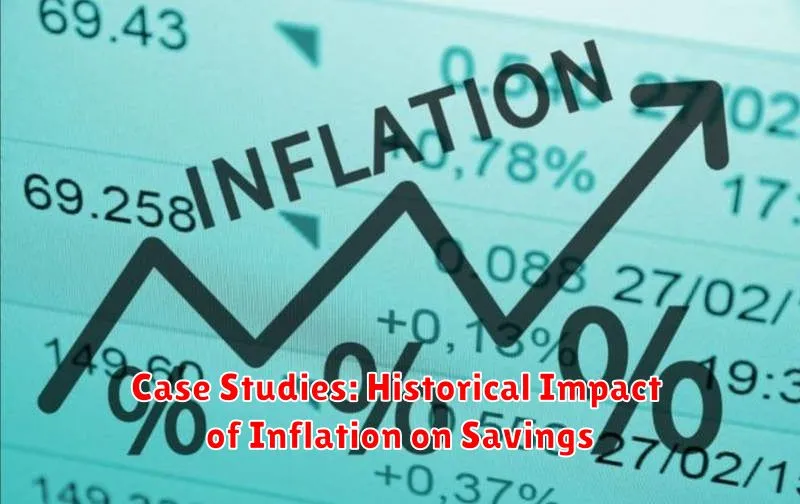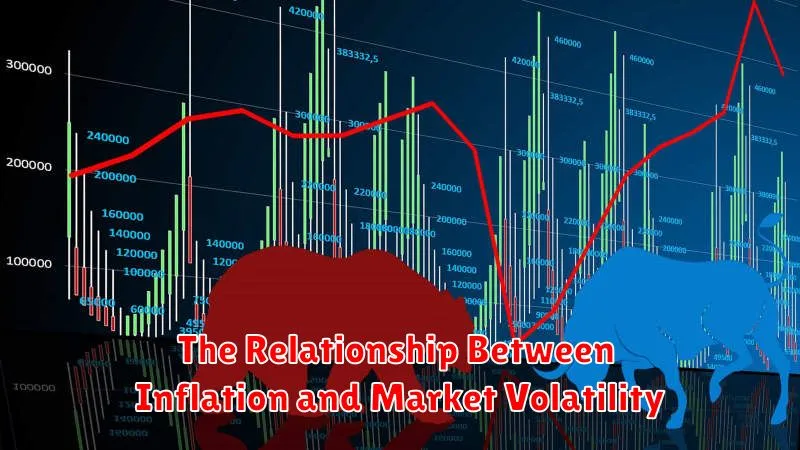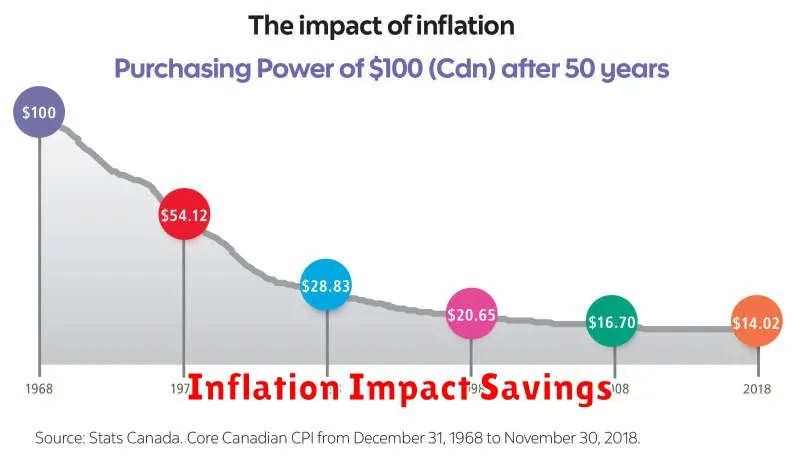Inflation is a silent thief that can slowly erode the value of your hard-earned savings. When prices rise, your money buys less, and your long-term savings may not grow as quickly as you expect. This can be particularly concerning for individuals who are saving for retirement, their children’s education, or other significant financial goals. The impact of inflation on your savings can be substantial, potentially jeopardizing your future financial well-being.
Understanding how inflation affects your savings is crucial for making informed financial decisions. By grasping the mechanisms of inflation, you can develop strategies to protect your savings and ensure they keep pace with rising prices. This article will delve into the financial impact of inflation on your long-term savings, examining the risks and opportunities associated with this economic phenomenon. We’ll explore strategies for mitigating the negative effects of inflation and maximizing the growth potential of your savings over time.
Understanding Inflation and Its Erosive Effects
Inflation is a natural part of the economy, representing a sustained increase in the general price level of goods and services over time. It essentially means that your money buys less today than it did yesterday. While moderate inflation is generally considered healthy for an economy, high inflation can significantly impact your long-term savings.
The core of inflation’s erosive effect lies in its ability to decrease the purchasing power of your savings. Imagine saving $1,000 today and expecting to use it for a significant purchase in ten years. If inflation averages 3% annually over that period, your $1,000 will only be worth around $740 in ten years. This means you’ll need to save more to achieve your financial goals, as the value of your savings is constantly diminishing.
Inflation’s impact on your savings is not limited to its direct reduction in purchasing power. It can also affect interest rates on your savings accounts, which are often linked to inflation. If interest rates rise to combat inflation, your savings may not keep up with the rising prices, further eroding their value.
The Impact of Inflation on Purchasing Power
Inflation is a natural part of a healthy economy, but it can have a significant impact on your long-term savings. When prices rise, your money buys less than it used to. This is known as the erosion of purchasing power. If you have money saved away, inflation can eat into your savings over time, reducing its real value.
For example, if you have $1,000 saved today and the inflation rate is 3% per year, you will need $1,030 next year to buy the same amount of goods and services. If you don’t earn a return on your savings that’s at least equal to the inflation rate, your money will be worth less in real terms. The higher the inflation rate, the faster your purchasing power declines.
The impact of inflation on purchasing power is especially noticeable over long periods. Even a seemingly small inflation rate of 2% per year can have a significant effect on your savings over 20 or 30 years. This is why it’s essential to understand how inflation can affect your long-term financial goals and take steps to protect your savings from its erosive effects.
How Inflation Affects Different Asset Classes (Stocks, Bonds, Real Estate)
Inflation can have a significant impact on your long-term savings by eroding the purchasing power of your money. Understanding how inflation affects different asset classes can help you make informed decisions about your investment strategy.
Stocks: Companies can often pass on higher costs to consumers through price increases, which can help protect their profit margins during inflationary periods. However, inflation can also lead to higher interest rates, making it more expensive for businesses to borrow money. These factors can affect stock prices, and investors need to carefully consider the potential impact of inflation on individual companies and sectors.
Bonds: Bonds typically lose value during periods of inflation. This is because rising interest rates make newly issued bonds more attractive to investors, leading to a decline in the value of existing bonds. If you hold bonds, you should consider diversifying your portfolio with other asset classes that may perform better during inflationary periods.
Real Estate: Real estate is often considered an inflation hedge. As prices for goods and services rise, the value of real estate tends to increase as well. However, rising interest rates can make mortgages more expensive, which could slow down demand for housing and impact the rate of appreciation.
It is important to note that inflation can impact different asset classes in different ways. It is crucial to develop a diversified portfolio that considers the potential impact of inflation and adjusts accordingly.
The Role of Interest Rates in Combating Inflation
Inflation, the persistent rise in the general price level of goods and services, can significantly erode the purchasing power of your savings. To combat this, central banks employ a key tool: interest rates. When inflation starts to rise, central banks often increase interest rates. This strategy works by making borrowing more expensive, thereby discouraging businesses and individuals from spending.
Here’s how it plays out:
- Higher interest rates on loans: Businesses may find it more costly to expand or invest, leading to slower economic growth and potentially lower demand for goods and services.
- More attractive returns on savings: People are encouraged to save more as they receive higher returns on their deposits, thus reducing spending and cooling down the economy.
By slowing down the economy, higher interest rates can help to reduce the pressure on prices, effectively combating inflation. However, the process of raising interest rates can also have unintended consequences, such as slowing down economic growth or even causing a recession.
Protecting Your Savings from Inflation: Diversification Strategies
Inflation, the persistent increase in the price of goods and services, can significantly erode the purchasing power of your hard-earned savings over time. To combat this challenge and protect your long-term financial goals, diversification is key. A well-diversified investment portfolio can help hedge against inflation by allocating assets across different asset classes with varying sensitivities to inflation.
One effective strategy is to include inflation-sensitive assets in your portfolio. These assets tend to perform well during periods of rising prices. Consider these options:
- Commodities: Raw materials like gold, oil, and agricultural products can appreciate in value when inflation is high, as their prices typically rise with increased demand.
- Real Estate: Investing in real estate, particularly rental properties, can provide a hedge against inflation. As rents increase, your investment can generate higher returns, offsetting the impact of rising prices.
- Inflation-Protected Securities: Government bonds such as Treasury Inflation-Protected Securities (TIPS) offer a principal amount that adjusts with inflation, helping to preserve the purchasing power of your investment.
Another crucial aspect of diversification is to include growth-oriented investments that have the potential to outpace inflation. These can include:
- Equities (Stocks): Companies that are able to pass on higher costs to consumers or innovate to increase efficiency can experience earnings growth that outperforms inflation.
- Alternative Investments: Investments like venture capital, private equity, and certain types of hedge funds can offer potential for high returns, potentially outperforming inflation over the long term.
While diversification can help mitigate the impact of inflation, it’s crucial to remember that there is no single strategy guaranteed to protect your savings completely. Consult with a qualified financial advisor to develop a personalized investment plan that aligns with your risk tolerance, time horizon, and financial goals.
Inflation-Adjusted Investments: TIPS and Real Estate
Inflation can significantly erode the purchasing power of your savings over time. To combat this, you can consider investing in inflation-adjusted investments, which are designed to protect your principal from the effects of rising prices.
Treasury Inflation-Protected Securities (TIPS) are government bonds whose principal value adjusts with inflation. As inflation rises, the principal value of TIPS increases, providing you with a hedge against inflation. The interest payments you receive on TIPS are also adjusted based on inflation.
Real estate is another asset class that can offer inflation protection. As prices rise, the value of your real estate holdings tends to increase as well. However, it’s important to note that the real estate market can be volatile, and its performance can be impacted by various factors, including local economic conditions and interest rates.
When considering inflation-adjusted investments, it’s crucial to understand the risks and potential returns associated with each asset class. Consult with a financial advisor to determine the best investment strategy for your specific financial goals and risk tolerance.
The Importance of a Long-Term Perspective on Inflation
When it comes to your long-term savings, it’s essential to adopt a long-term perspective on inflation. While short-term fluctuations in inflation can be concerning, it’s important to remember that inflation is a natural part of a healthy economy. Over the long term, inflation has historically averaged around 3% annually. This means that the purchasing power of your money will gradually erode over time.
However, a long-term perspective allows you to plan and adjust your investment strategies to account for the effects of inflation. This involves choosing investments with the potential to outpace inflation, such as stocks and real estate, which have historically provided higher returns than inflation. It also means considering inflation when setting your savings goals and retirement plans. For example, if you’re saving for retirement 30 years from now, you’ll need to factor in the erosion of purchasing power due to inflation.
By taking a long-term approach, you can reduce the impact of inflation on your savings and ensure that your money continues to grow and maintain its value over time. It’s also important to remember that inflation is just one factor to consider when making investment decisions. Other factors, such as your risk tolerance and financial goals, should also play a role in your investment strategy.
Adjusting Your Retirement Plan for Inflation
Inflation is a major concern for retirees, as it can significantly erode the purchasing power of their savings. Adjusting your retirement plan for inflation is crucial to ensure you have enough money to live comfortably in your later years.
Here are some steps you can take to adjust your retirement plan for inflation:
- Increase your contributions: As inflation rises, you’ll need to contribute more to your retirement accounts to keep pace with the rising cost of living.
- Invest in assets that are likely to outpace inflation: Consider investments like stocks and real estate, which historically have outpaced inflation.
- Consider a higher withdrawal rate: You may need to withdraw more from your retirement accounts to maintain your standard of living.
- Rebalance your portfolio regularly: Rebalancing your portfolio ensures that your investments are properly allocated to help you adjust to changes in the market.
- Stay informed about inflation trends: Monitor inflation rates and adjust your plan accordingly.
By taking these steps, you can help ensure that your retirement savings will keep pace with inflation and provide you with the financial security you need in retirement.
Seeking Professional Financial Advice During Inflationary Periods
Navigating inflation can be challenging, especially when it comes to your long-term savings. During these times, it’s crucial to seek professional financial advice from a qualified advisor. A financial advisor can help you develop a personalized strategy to protect and grow your savings, even in a volatile economic climate.
Here are some key reasons why seeking professional guidance is essential during inflationary periods:
- Inflation-Proofing Your Portfolio: An advisor can help you adjust your investment portfolio to mitigate the impact of inflation. This might involve diversifying into assets that tend to perform well during inflationary periods, such as commodities or real estate.
- Assessing Your Risk Tolerance: Inflation can increase the risk of your investments. A financial advisor can assess your risk tolerance and adjust your investment strategy accordingly. They can help you find a balance between growth potential and risk management.
- Reviewing Your Financial Goals: Your financial goals might need to be reevaluated in light of inflation. An advisor can help you adjust your savings targets and timelines to account for the increased cost of living.
- Exploring Alternative Investment Options: A financial advisor can introduce you to alternative investment options that might provide protection against inflation, such as high-yield bonds or inflation-linked securities.
In conclusion, seeking professional financial advice during inflationary periods is a wise decision that can help you safeguard your long-term savings and achieve your financial goals.
Case Studies: Historical Impact of Inflation on Savings

To truly understand the long-term impact of inflation on your savings, it’s helpful to look at historical examples. Here are a few case studies that illustrate how inflation can erode the purchasing power of your hard-earned money over time:
1. The Weimar Republic (1921-1923): In Germany after World War I, hyperinflation spiraled out of control. The value of the German mark plummeted so rapidly that people needed wheelbarrows full of cash to buy a loaf of bread. This illustrates the extreme scenario where savings can be rendered nearly worthless by inflation.
2. The United States in the 1970s: The US experienced a period of high inflation in the 1970s, with rates reaching over 14% in 1979. This meant that the purchasing power of savings declined significantly over the decade. Those who saved in fixed-income investments, such as bonds, saw their returns eroded by rising prices.
3. Venezuela in the 21st Century: More recently, Venezuela has been grappling with hyperinflation, with the value of the Bolivar falling dramatically. This has led to severe economic hardship for many Venezuelans, highlighting the devastating impact inflation can have on savings and the overall economy.
These historical examples demonstrate the importance of understanding the potential impact of inflation on your long-term savings. It’s crucial to consider strategies for protecting your savings from the eroding effects of inflation, such as investing in assets that have historically kept pace with inflation or choosing investments that provide a return that outpaces inflation.
Strategies for Mitigating Inflation Risk in Your Portfolio

Inflation is a major concern for long-term investors, as it erodes the purchasing power of your savings over time. A well-diversified portfolio is essential to help you stay ahead of inflation, and several strategies can help you mitigate its impact. Here are a few to consider:
1. Invest in Inflation-Protected Securities
Treasury Inflation-Protected Securities (TIPS) are bonds whose principal value adjusts with inflation. This means that as inflation rises, so too does the value of your investment, helping to protect your purchasing power.
2. Diversify Your Portfolio
A diversified portfolio helps to reduce the impact of inflation on your investments. By investing in a variety of asset classes, such as stocks, bonds, real estate, and commodities, you spread your risk and increase your chances of positive returns even during inflationary periods.
3. Consider Value Stocks
Value stocks are often seen as a good hedge against inflation because they tend to perform well in periods of economic uncertainty. Value stocks typically have lower valuations than growth stocks and may be more likely to benefit from rising inflation.
4. Invest in Real Estate
Real estate is a traditional inflation hedge. As the cost of goods and services increases, so too does the value of real estate, potentially providing a buffer against inflation.
5. Focus on Growth Stocks
Growth stocks are companies that reinvest their earnings back into the business, enabling them to expand rapidly. While growth stocks may be more vulnerable to inflation in the short term, they could potentially outperform over the long term if they can maintain their growth trajectory.
6. Adjust Your Investment Strategy
It’s crucial to regularly review your investment strategy and make adjustments as needed. This may involve increasing your exposure to inflation-hedging assets, reducing your overall risk tolerance, or shifting your investment focus from growth to value.
The Relationship Between Inflation and Market Volatility

Inflation and market volatility have a complex and intertwined relationship. Inflation, a general increase in the price of goods and services over time, can significantly impact market volatility. When inflation rises, it erodes the purchasing power of money, making investors demand higher returns on their investments to compensate for the loss in value. This increased demand for higher returns can lead to greater price fluctuations in the market, creating volatility.
Market volatility, on the other hand, can also influence inflation. High market volatility can lead to uncertainty in the economy, making businesses hesitant to invest and expand, potentially slowing economic growth. This, in turn, can contribute to inflation as businesses pass on higher costs to consumers. A volatile market can also make it difficult for central banks to effectively manage inflation, as they need to balance the need to control inflation with the need to support economic growth.
The relationship between inflation and market volatility is dynamic and constantly evolving. Understanding this relationship is crucial for investors seeking to manage their long-term savings effectively. It requires considering both the potential benefits and risks of inflation and market volatility to make informed decisions about investment strategies and portfolio diversification.

